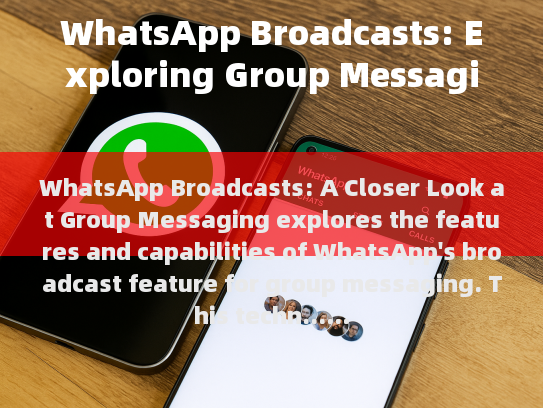WhatsApp Broadcasts: Exploring Group Messaging Features,In the realm of messaging apps, WhatsApp has been continuously evolving its features to enhance user experience and keep up with modern communication trends. One notable feature is the introduction of Broadcasts in WhatsApp Groups. This new functionality allows users to send messages to all members of a group without individually addressing each member, which can be particularly useful for sharing updates or announcements within large groups.,Broadcasts offer several benefits:,1. **Efficiency**: By sending messages to multiple recipients at once, Broadcasts save time and effort compared to individual message sends.,2. **Scalability**: The system can handle larger groups more effectively than traditional group chats, making it ideal for communities where participation is widespread but not necessarily high.,3. **Accessibility**: Messages sent through Broadcasts do not require any specific permissions from other users, ensuring that everyone who joins the group receives the update promptly.,The implementation of Broadcasts aligns well with the app's core mission to provide seamless and efficient communication tools, especially beneficial for businesses and community platforms where rapid dissemination of information is crucial. As technology continues to advance, WhatsApp likely will incorporate further improvements and enhancements to its broadcasting capabilities, potentially leading to even greater efficiency and convenience in group messaging.
Explore the Features and Capabilities of WhatsApp's Broadcast Feature for Group Messaging.
This article delves into the features and functionalities of WhatsApp's broadcast feature, focusing on how it enhances communication efficiency in groups. The technology allows users to send messages to multiple recipients simultaneously without individual notifications. This feature is especially beneficial for real-time updates and collaborative projects within communities or teams. Privacy concerns and potential misuse of the broadcast function are also discussed. For those seeking to understand more about managing large-scale messaging engagements, this comprehensive look offers valuable insights into WhatsApp's innovative group messaging solution.
In the ever-evolving landscape of social media and communication platforms, WhatsApp stands out as one of the most widely used messaging applications globally. With over 2 billion active users worldwide, WhatsApp's robust feature set, including broadcasts, continues to attract both newcomers and experienced users alike.

What Are WhatsApp Broadcasts?
A WhatsApp broadcast is essentially a group chat that allows multiple recipients to receive messages simultaneously without each user having their own individual conversation with the sender. This feature is particularly advantageous in situations where reaching a large audience quickly is needed or when immediate dissemination of critical information is required.
Key Features of WhatsApp Broadcasts
- Ease of Use: Unlike traditional group chats, which necessitate creating separate conversations for each participant, broadcasts enable all members to view and react to a message simultaneously.
- Quick Distribution: Broadcasts can be sent instantly to all participants within seconds, perfect for fast-paced updates, notifications, or promotional content.
- Customizable Settings: Users can customize broadcast settings, such as sending it once, deleting after a certain period, or selecting specific groups of contacts.
- Privacy Control: Despite facilitating quick distribution, broadcasts offer some degree of privacy via options like hiding the sender's name and allowing recipients to decide whether to reply privately or publicly.
The Importance of WhatsApp Broadcasts
In today’s digital age, where instant communication is paramount, WhatsApp broadcasts play a significant role in various industries:
- Businesses: Companies use broadcasts to disseminate product launches, service announcements, promotions, and marketing materials to targeted audiences. They can also promote internal communications among teams or stakeholders, keeping everyone informed about company activities.
- Educational Institutions: Schools and universities employ broadcasts to notify students, faculty, and staff about school announcements, academic events, and extracurricular activities. This maintains transparency and engagement among stakeholders.
- Non-Profit Organizations: Non-profit entities frequently use broadcasts to communicate with donors, volunteers, and beneficiaries concerning fundraising campaigns, upcoming events, and progress reports on initiatives.
- Media Outlets: News organizations and broadcasters leverage broadcasts to distribute breaking news stories, interviews, and live streams efficiently to broad audiences.
Best Practices for Using WhatsApp Broadcasts Effectively
While WhatsApp broadcasts offer substantial advantages, effective utilization hinges on adhering to best practices:
- Targeted Audience Selection: Select your audience wisely based on relevance and interest; avoid sending broadcasts to irrelevant lists.
- Clear Communication: Ensure the content is clear, concise, and pertinent to your target audience. Avoid using overly complex terminology if not essential.
- Regular Updates: Maintain broadcasts fresh and updated regularly to keep the audience engaged and aware of ongoing developments.
- Feedback Mechanism: Implement a feedback system within the broadcast to encourage responses from all recipients. Responses can aid in refining future broadcasts and addressing any issues promptly.
- Security Measures: Although WhatsApp broadcasts generally offer strong security measures due to end-to-end encryption, reminders to safeguard devices and avoid unnecessary personal information sharing should be emphasized.
Conclusion
WhatsApp broadcasts are indispensable tools in modern communication strategies, providing businesses, educational institutions, non-profits, and media outlets with powerful methods to swiftly and effectively disseminate information. Understanding how to use these tools responsibly and strategically can significantly enhance organizational effectiveness while upholding ethical standards in communication practices. As technology advances, it remains crucial for users and administrators to stay informed about the latest features and best practices associated with group messaging.
